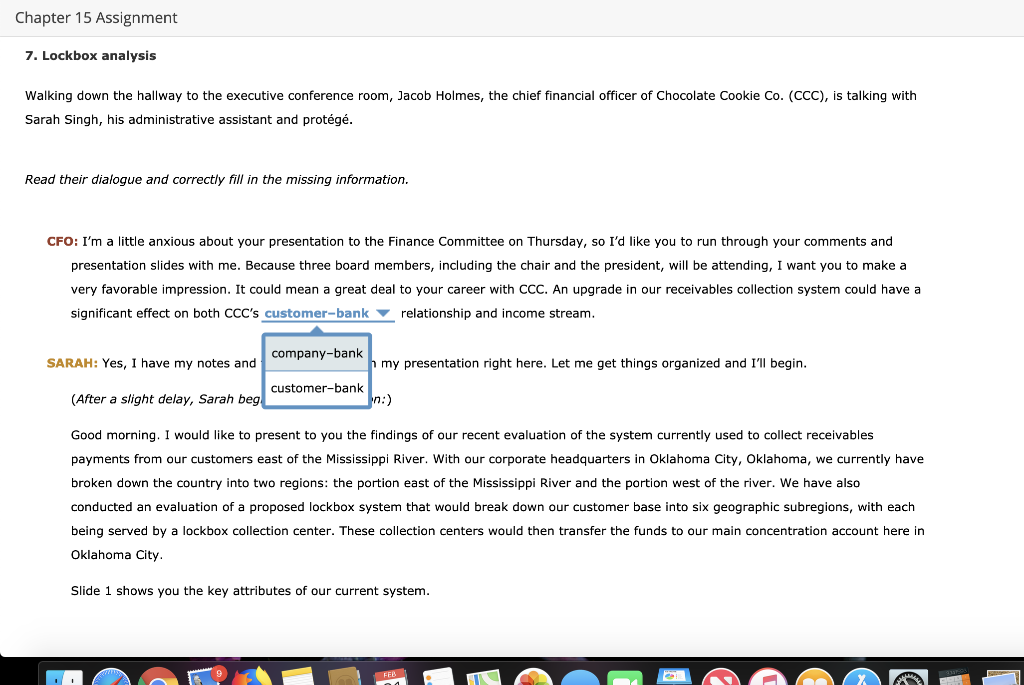
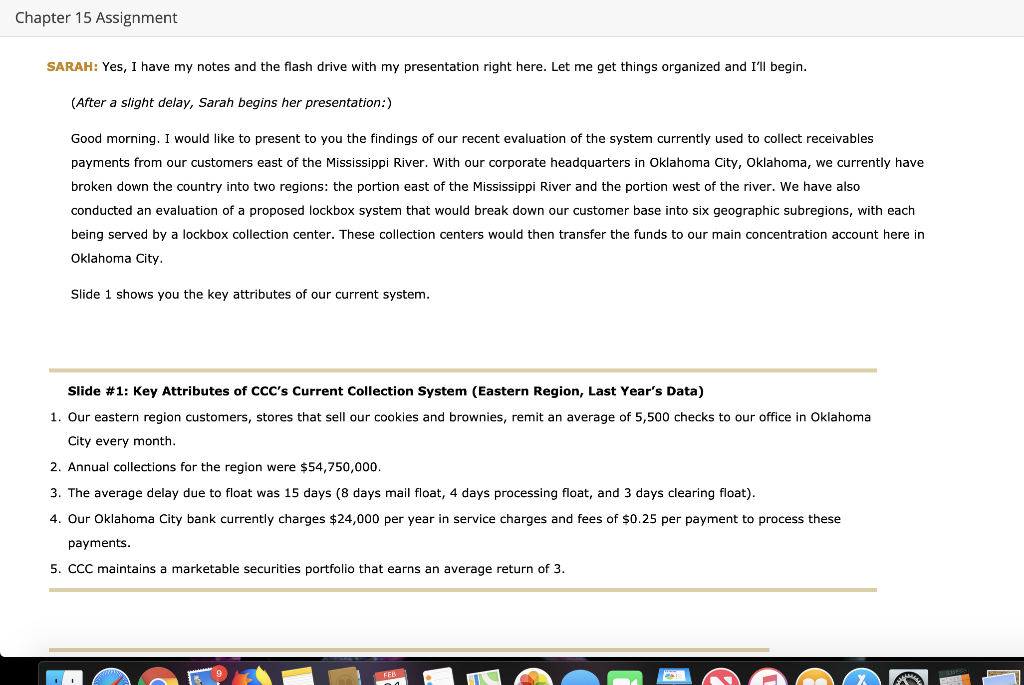
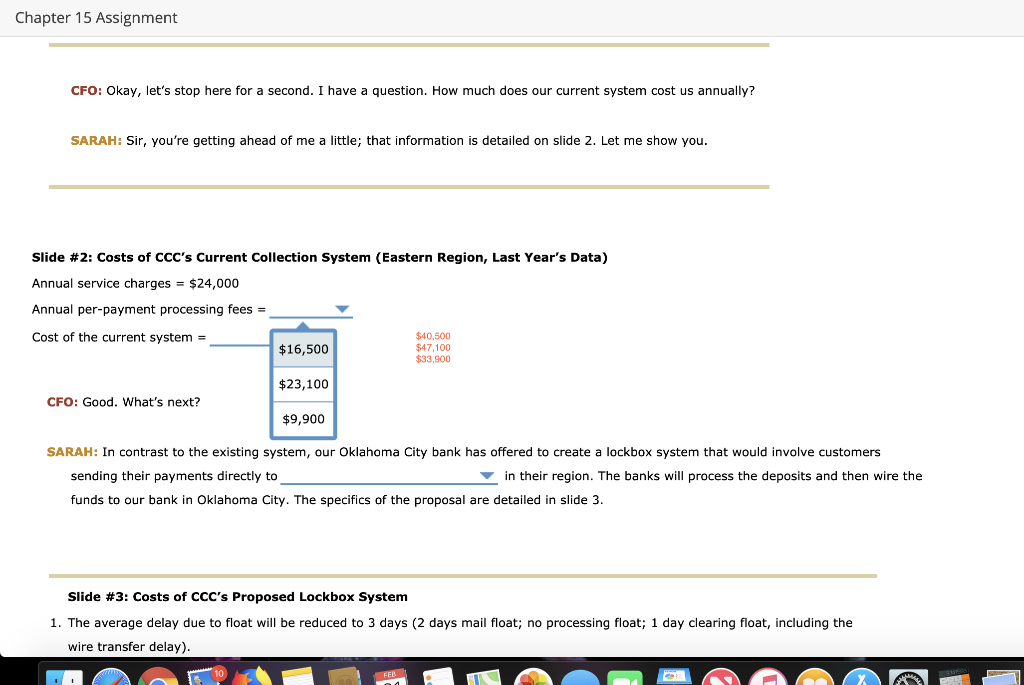
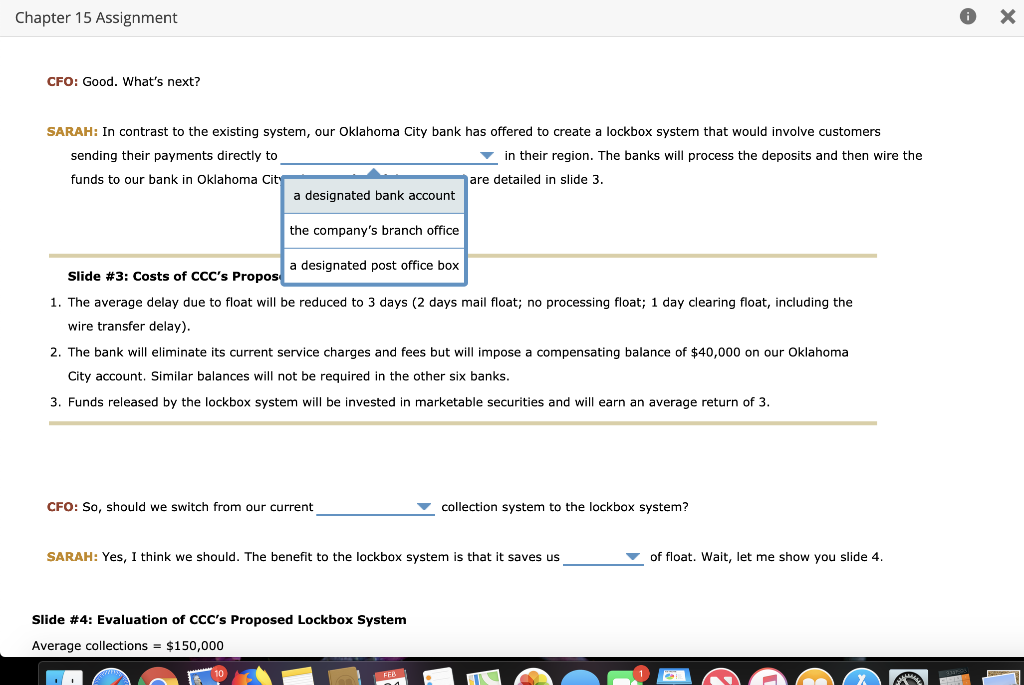
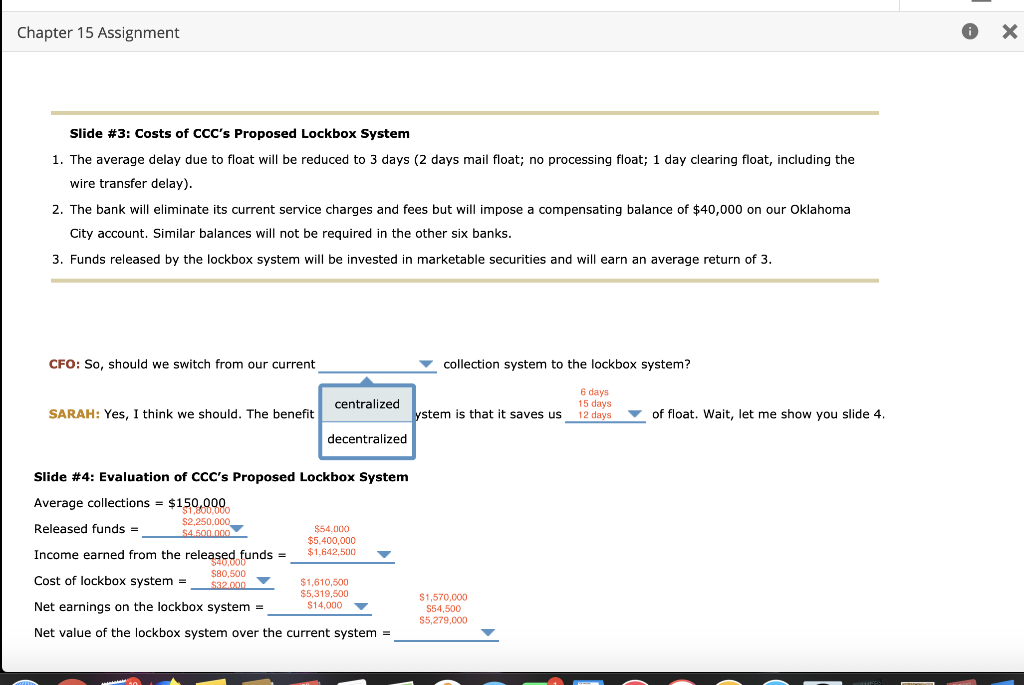
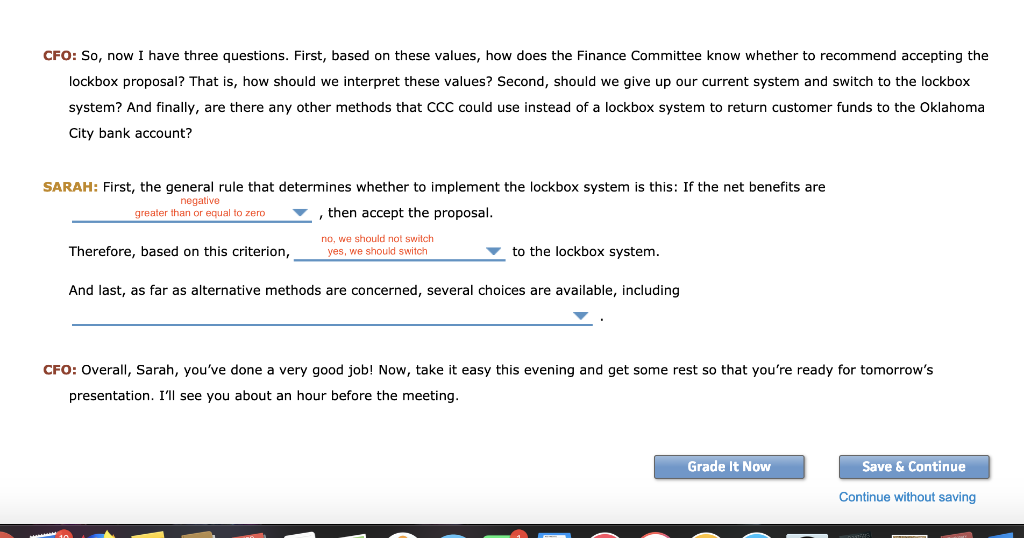
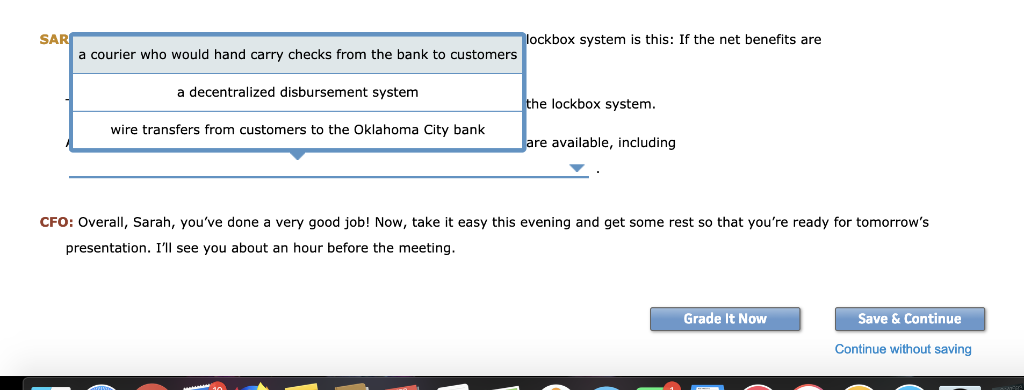 I need help with this exercise please, I'm showing the options to choose from.
I need help with this exercise please, I'm showing the options to choose from.
Chapter 15 Assignment 7. Lockbox analysis Walking down the hallway to the executive conference room, Jacob Holmes, the chief financial officer of Chocolate Cookie Co. (CCC), is talking with Sarah Singh, his administrative assistant and protg. Read their dialogue and correctly fill in the missing information CFO: I'm a little anxious about your presentation to the Finance Committee on Thursday, so I'd like you to run through your comments and presentation slides with me. Because three board members, including the chair and the president, will be attending, I want you to make a very favorable impression. It could mean a great deal to your career with CCC. An upgrade in our receivables collection system could have a significant effect on both CCC's customer-bankrelationship and income stream SARAH: Yes, I have my notes and e my notes and Company-bank my presentation right here. Let me get things organized and I'll begin (After a slight delay, Sarah beg Good morning. I would like to present to you the findings of our recent evaluation of the system currently used to collect receivables payments from our customers east of the Mississippi River. With our corporate headquarters in Oklahoma City, Oklahoma, we currently have broken down the country into two regions: the portion east of the Mississippi River and the portion west of the river. We have also conducted an evaluation of a proposed lockbox system that would break down our customer base into six geographic subregions, with each being served by a lockbox collection center. These collection centers would then transfer the funds to our main concentration account here in Oklahoma City. Slide 1 shows you the key attributes of our current system Chapter 15 Assignment SARAH: Yes, I have my notes and the flash drive with my presentation right here. Let me get things organized and I'll begin. (After a slight delay, Sarah begins her presentation:) Good morning. I would like to present to you the findings of our recent evaluation of the system currently used to collect receivables payments from our customers east of the Mississippi River. With our corporate headquarters in Oklahoma City, Oklahoma, we currently have broken down the country into two regions: the portion east of the Mississippi River and the portion west of the river. We have also conducted an evaluation of a proposed lockbox system that would break down our customer base into six geographic subregions, with each being served by a lockbox collection center. These collection centers would then transfer the funds to our main concentration account here in Oklahoma City. Slide 1 shows you the key attributes of our current system. Slide # 1: Key Attributes of CCC's current Collection System (Eastern Region, Last Year's Data) 1. Our eastern region customers, stores that sell our cookies and brownies, remit an average of 5,500 checks to our office in Oklahoma City every month 2. Annual collections for the region were $54,750,000 3. The average delay due to float was 15 days (8 days mail float, 4 days processing float, and 3 days clearing float) 4. Our Oklahoma City bank currently charges $24,000 per year in service charges and fees of $0.25 per payment to process these payments. 5. CCC maintains a marketable securities portfolio that earns an average return of Chapter 15 Assignment CFO: Okay, let's stop here for a second. I have a question. How much does our current system cost us annually? SARAH: Sir, you're getting ahead of me a little; that information is detailed on slide 2. Let me show you. Slide #2: Costs of CCC's Current Collection System (Eastern Region, Last Years Data Annual service charges $24,000 Annual per-payment processing fees- Cost of the current system- $40,500 $47,100 $33,900 $16,500 $23,100 $9,900 CFO: Good. What's next? SARAH: In contrast to the existing system, our Oklahoma City bank has offered to create a lockbox system that would involve customers sending their payments directly to in their region. The banks will process the deposits and then wire the funds to our bank in Oklahoma City. The specifics of the proposal are detailed in slide 3. Slide #3: Costs of CCC's Proposed Lockbox System 1. The average delay due to float will be reduced to 3 days (2 days mail float; no processing float; 1 day clearing float, including the wire transfer delay) Chapter 15 Assignment CFO: Good. What's next? SARAH: In contrast to the existing system, our Oklahoma City bank has offered to create a lockbox system that would involve customers sending their payments directly to funds to our bank in Oklahoma City in their region. The banks will process the deposits and then wire the are detailed in slide3 a designated bank account the company's branch office a designated post office box Slide #3: Costs of CCC's Propos 1. The average delay due to float will be reduced to 3 days (2 days mail float; no processing float; 1 day clearing float, including the wire transfer delay) 2. The bank will eliminate its current service charges and fees but will impose a compensating balance of $40,000 on our Oklahoma City account. Similar balances will not be required in the other six banks. 3. Funds released by the lockbox system will be invested in marketable securities and will earn an average return of 3. CFO: So, should we switch from our current collection system to the lockbox system? SARAH: Yes, I think we should. The benefit to the lockbox system is that it saves us of float. Wait, let me show you slide 4. Slide #4: Evaluation of CCC's Proposed Lockbox System Average collections $150,000 Chapter 15 Assignment Slide #3: Costs of CCC's Proposed Lockbox System 1. The average delay due to float will be reduced to 3 days (2 days mail float; no processing float; 1 day clearing float, including the wire transfer delay) 2. The bank will eliminate its current service charges and fees but will impose a compensating balance of $40,000 on our Oklahoma City account. Similar balances will not be required in the other six banks 3. Funds released by the lockbox system will be invested in marketable securities and will earn an average return of 3 CFO: So, should we switch from our current collection system to the lockbox system? 6 days 15 days centralized SARAH: Yes, I think we should. The benefit stem is that it saves us 12 days of float. Wait, let me show you slide 4 decentralized Slide #4: Evaluation of CCC's Proposed Lockbox System Average collections $150,000 Released funds - Income earned from the released funds$1,842,500 Cost of lockbox system000$1,610,500 Net earnings on the lockbox system Net value of the lockbox system over the current system $2,250,000 $54.000 $5.400,000 $80,500 $5,319,500 $14,000 S1,570,000 $54,500 $5,279,000 CFO: So, now I have three questions. First, based on these values, how does the Finance Committee know whether to recommend accepting the lockbox proposal? That is, how should we interpret these values? Second, should we give up our current system and switch to the lockbox system? And finally, are there any other methods that CCC could use instead of a lockbox system to return customer funds to the Oklahoma City bank account? SARAH: First, the general rule that determines whether to implement the lockbox system is this: If the net benefits are negative greater than or equal to zero , then accept the proposal. no, we should not switch Therefore, based on this criterion, yes, we should switch to the lockbox system. And last, as far as alternative methods are concerned, several choices are available, including CFO: Overall, Sarah, you've done a very good job! Now, take it easy this evening and get some rest so that you're ready for tomorrow's presentation. I'll see you about an hour before the meeting. Grade It Now Save & Continue Continue without saving SAR lockbox system is this: If the net benefits are a courier who would hand carry checks from the bank to customers a decentralized disbursement system wire transfers from customers to the Oklahoma City bank the lockbox system. are available, including CFO: Overall, Sarah, you've done a very good job! Now, take it easy this evening and get some rest so that you're ready for tomorrow's presentation. I'll see you about an hour before the meeting. Grade It Now Save & Continue Continue without saving Chapter 15 Assignment 7. Lockbox analysis Walking down the hallway to the executive conference room, Jacob Holmes, the chief financial officer of Chocolate Cookie Co. (CCC), is talking with Sarah Singh, his administrative assistant and protg. Read their dialogue and correctly fill in the missing information CFO: I'm a little anxious about your presentation to the Finance Committee on Thursday, so I'd like you to run through your comments and presentation slides with me. Because three board members, including the chair and the president, will be attending, I want you to make a very favorable impression. It could mean a great deal to your career with CCC. An upgrade in our receivables collection system could have a significant effect on both CCC's customer-bankrelationship and income stream SARAH: Yes, I have my notes and e my notes and Company-bank my presentation right here. Let me get things organized and I'll begin (After a slight delay, Sarah beg Good morning. I would like to present to you the findings of our recent evaluation of the system currently used to collect receivables payments from our customers east of the Mississippi River. With our corporate headquarters in Oklahoma City, Oklahoma, we currently have broken down the country into two regions: the portion east of the Mississippi River and the portion west of the river. We have also conducted an evaluation of a proposed lockbox system that would break down our customer base into six geographic subregions, with each being served by a lockbox collection center. These collection centers would then transfer the funds to our main concentration account here in Oklahoma City. Slide 1 shows you the key attributes of our current system Chapter 15 Assignment SARAH: Yes, I have my notes and the flash drive with my presentation right here. Let me get things organized and I'll begin. (After a slight delay, Sarah begins her presentation:) Good morning. I would like to present to you the findings of our recent evaluation of the system currently used to collect receivables payments from our customers east of the Mississippi River. With our corporate headquarters in Oklahoma City, Oklahoma, we currently have broken down the country into two regions: the portion east of the Mississippi River and the portion west of the river. We have also conducted an evaluation of a proposed lockbox system that would break down our customer base into six geographic subregions, with each being served by a lockbox collection center. These collection centers would then transfer the funds to our main concentration account here in Oklahoma City. Slide 1 shows you the key attributes of our current system. Slide # 1: Key Attributes of CCC's current Collection System (Eastern Region, Last Year's Data) 1. Our eastern region customers, stores that sell our cookies and brownies, remit an average of 5,500 checks to our office in Oklahoma City every month 2. Annual collections for the region were $54,750,000 3. The average delay due to float was 15 days (8 days mail float, 4 days processing float, and 3 days clearing float) 4. Our Oklahoma City bank currently charges $24,000 per year in service charges and fees of $0.25 per payment to process these payments. 5. CCC maintains a marketable securities portfolio that earns an average return of Chapter 15 Assignment CFO: Okay, let's stop here for a second. I have a question. How much does our current system cost us annually? SARAH: Sir, you're getting ahead of me a little; that information is detailed on slide 2. Let me show you. Slide #2: Costs of CCC's Current Collection System (Eastern Region, Last Years Data Annual service charges $24,000 Annual per-payment processing fees- Cost of the current system- $40,500 $47,100 $33,900 $16,500 $23,100 $9,900 CFO: Good. What's next? SARAH: In contrast to the existing system, our Oklahoma City bank has offered to create a lockbox system that would involve customers sending their payments directly to in their region. The banks will process the deposits and then wire the funds to our bank in Oklahoma City. The specifics of the proposal are detailed in slide 3. Slide #3: Costs of CCC's Proposed Lockbox System 1. The average delay due to float will be reduced to 3 days (2 days mail float; no processing float; 1 day clearing float, including the wire transfer delay) Chapter 15 Assignment CFO: Good. What's next? SARAH: In contrast to the existing system, our Oklahoma City bank has offered to create a lockbox system that would involve customers sending their payments directly to funds to our bank in Oklahoma City in their region. The banks will process the deposits and then wire the are detailed in slide3 a designated bank account the company's branch office a designated post office box Slide #3: Costs of CCC's Propos 1. The average delay due to float will be reduced to 3 days (2 days mail float; no processing float; 1 day clearing float, including the wire transfer delay) 2. The bank will eliminate its current service charges and fees but will impose a compensating balance of $40,000 on our Oklahoma City account. Similar balances will not be required in the other six banks. 3. Funds released by the lockbox system will be invested in marketable securities and will earn an average return of 3. CFO: So, should we switch from our current collection system to the lockbox system? SARAH: Yes, I think we should. The benefit to the lockbox system is that it saves us of float. Wait, let me show you slide 4. Slide #4: Evaluation of CCC's Proposed Lockbox System Average collections $150,000 Chapter 15 Assignment Slide #3: Costs of CCC's Proposed Lockbox System 1. The average delay due to float will be reduced to 3 days (2 days mail float; no processing float; 1 day clearing float, including the wire transfer delay) 2. The bank will eliminate its current service charges and fees but will impose a compensating balance of $40,000 on our Oklahoma City account. Similar balances will not be required in the other six banks 3. Funds released by the lockbox system will be invested in marketable securities and will earn an average return of 3 CFO: So, should we switch from our current collection system to the lockbox system? 6 days 15 days centralized SARAH: Yes, I think we should. The benefit stem is that it saves us 12 days of float. Wait, let me show you slide 4 decentralized Slide #4: Evaluation of CCC's Proposed Lockbox System Average collections $150,000 Released funds - Income earned from the released funds$1,842,500 Cost of lockbox system000$1,610,500 Net earnings on the lockbox system Net value of the lockbox system over the current system $2,250,000 $54.000 $5.400,000 $80,500 $5,319,500 $14,000 S1,570,000 $54,500 $5,279,000 CFO: So, now I have three questions. First, based on these values, how does the Finance Committee know whether to recommend accepting the lockbox proposal? That is, how should we interpret these values? Second, should we give up our current system and switch to the lockbox system? And finally, are there any other methods that CCC could use instead of a lockbox system to return customer funds to the Oklahoma City bank account? SARAH: First, the general rule that determines whether to implement the lockbox system is this: If the net benefits are negative greater than or equal to zero , then accept the proposal. no, we should not switch Therefore, based on this criterion, yes, we should switch to the lockbox system. And last, as far as alternative methods are concerned, several choices are available, including CFO: Overall, Sarah, you've done a very good job! Now, take it easy this evening and get some rest so that you're ready for tomorrow's presentation. I'll see you about an hour before the meeting. Grade It Now Save & Continue Continue without saving SAR lockbox system is this: If the net benefits are a courier who would hand carry checks from the bank to customers a decentralized disbursement system wire transfers from customers to the Oklahoma City bank the lockbox system. are available, including CFO: Overall, Sarah, you've done a very good job! Now, take it easy this evening and get some rest so that you're ready for tomorrow's presentation. I'll see you about an hour before the meeting. Grade It Now Save & Continue Continue without saving






 I need help with this exercise please, I'm showing the options to choose from.
I need help with this exercise please, I'm showing the options to choose from. 





